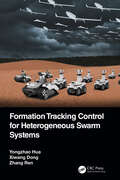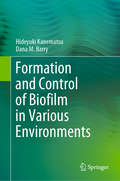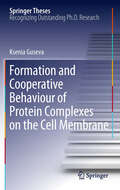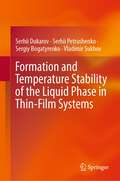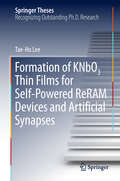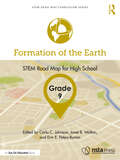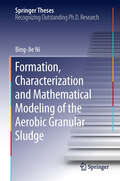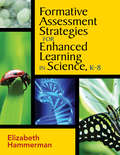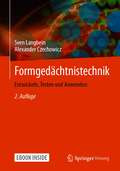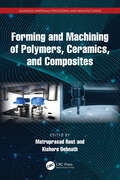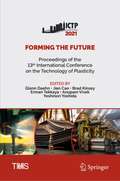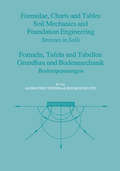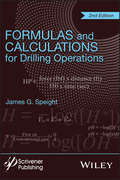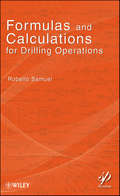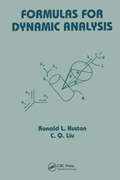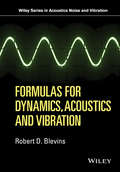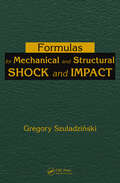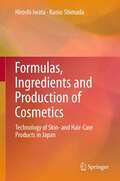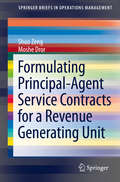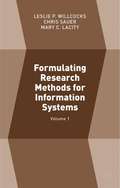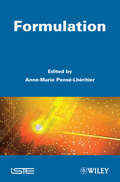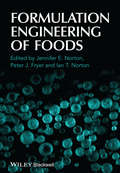- Table View
- List View
Formation Tracking Control for Heterogeneous Swarm Systems
by Xiwang Dong Yongzhao Hua Zhang RenSwarm system, also known as multi-agent system, refers to a system composed of multiple subsystems (agents) with certain communication, calculation, decision-making, and action capabilities through local information interaction, such as a group of unmanned aerial vehicles (UAVs), unmanned ground vehicles (UGVs), satellites, etc. Formation tracking control of swarm systems is an important technical support and approach for the emergence of swarm intelligence at motion control level. By applying formation tracking control, swarm system agents can adjust their relations in the state or output space through neighboring information interaction, and then the swarm system can achieve favorable space-time conditions for many cooperative tasks such as source seeking, target enclosing, and surveillance. Thus, complex missions can be performed efficiently or cost-effectively. In cross-domain collaborative applications, including air-ground coordination and air-sea coordination, swarm systems are usually composed of several heterogeneous agents, and swarm intelligence can be enhanced by complementary functions of different agents. How to achieve time-varying formation tracking for heterogeneous swarm systems is crucial for cross-domain coordination, which has important theoretical value and practical significance. This important book presents a systematic theoretical approach and control framework on the time-varying formation tracking for high-order heterogeneous swarm systems. Distributed controller design and stability analysis of closed-loop systems for several specific formation tracking problems are provided. Furthermore, the proposed control approaches are applied to practical cooperative experiment platforms composed of UAVs and UGVs, and several formation tracking experiments are carried out to further verify the effectiveness of the theories.
Formation and Control of Biofilm in Various Environments
by Hideyuki Kanematsu Dana M. BarryThis book provides excellent techniques for detecting and evaluating biofilms: sticky films on materials that are formed by bacterial activity and produce a range of industrial and medical problems such as corrosion, sanitary problems, and infections. Accordingly, it is essential to control biofilms and to establish appropriate countermeasures, from both industrial and medical viewpoints. This book offers valuable, detailed information on these countermeasures. It also discusses the fundamentals of biofilms, relates various substrates to biofilms, and presents a variety of biofilm reactors. However, the most important feature of this book (unlike others on the market) is its clear focus on addressing the practical aspects from an engineering viewpoint. Therefore, it offers an excellent practical guide for engineers and researchers in various fields, and can also be used as a great academic textbook.
Formation and Cooperative Behaviour of Protein Complexes on the Cell Membrane
by Ksenia GusevaWith the aim of providing a deeper insight into possible mechanisms of biological self-organization, this thesis presents new approaches to describe the process of self-assembly and the impact of spatial organization on the function of membrane proteins, from a statistical physics point of view. It focuses on three important scenarios: the assembly of membrane proteins, the collective response of mechanosensitive channels and the function of the twin arginine translocation (Tat) system. Using methods from equilibrium and non-equilibrium statistical mechanics, general conclusions were drawn that demonstrate the importance of the protein-protein interactions. Namely, in the first part a general aggregation dynamics model is formulated, and used to show that fragmentation crucially affects the efficiency of the self-assembly process of proteins. In the second part, by mapping the membrane-mediated forces into a simplified many-body system, the dynamic and equilibrium behaviour of interacting mechanosensitive channels is derived, showing that protein agglomeration strongly impacts its desired function. The final part develops a model that incorporates both the agglomeration and transport function of the Tat system, thereby providing a comprehensive description of this self-organizing process.
Formation and Temperature Stability of the Liquid Phase in Thin-Film Systems
by Serhii Dukarov Serhii Petrushenko Sergiy Bogatyrenko Vladimir SukhovThis book presents a summary of the topic of supercooling during crystallization in condensed films. While recent findings are mainly published in English, the foundational classical results were originally published in Russian, with limited accessibility to general readers. The present work is based on a 2019 Ukrainian monograph, "Temperature Stability of the Supercooled Liquid Phase in Condensed Films," which has been extensively revised and expanded.The book includes a detailed analysis of the thermodynamics of supercooled fluids, with updated and expanded sections. Additionally, new results on the supercooling of indium-lead (In-Pb) alloys in contact with amorphous molybdenum and fusible metals in contact with nanocrystalline layers are presented. These layers occupy a middle ground between amorphous (carbon, molybdenum, as-deposited germanium films) and polycrystalline (copper, silver, aluminum) substrates. The book gives particular attention to the peculiarities of contracted geometry conditions, which are natural for multilayered structures and can occur through fusible component segregation at grain boundaries.The analysis of new data has prompted a rethinking of the role of the more refractory layer's microstructure on the crystallization processes of metastable melts. The book includes a thorough discussion of these findings, highlighting the crucial role of the microstructure in the crystallization process. This book is a valuable resource for researchers and students interested in crystallization in thin-film metallic systems. This comprehensive study provides a detailed and authoritative analysis of the thermodynamics of supercooled fluids, and the impact of microstructure on the crystallization processes of metastable melts, making it an essential addition to any academic library.
Formation of KNbO3 Thin Films for Self-Powered ReRAM Devices and Artificial Synapses (Springer Theses)
by Tae-Ho LeeThis thesis describes an investigation into homogeneous KN crystalline films grown on Pt/Ti/SiO2/Si substrates, amorphous KN films grown on TiN/Si substrates using the RF-sputtering method, and the ferroelectic and piezoelectric properties of these KN films. KNbO3 (KN) thin films have been extensively investigated for applications in nonlinear optical, electro-optical and piezoelectric devices. However, the electrical properties of KN films have not yet been reported, because it is difficult to grow stoichiometric KN thin films due to K2O evaporation during growth. This thesis also reports on the ReRAM properties of a biocompatible KN ReRAM memristor powered by the KN nanogenerator, and finally shows the biological synaptic properties of the KN memristor for application to the artificial synapse of a neuromorphic computing system.
Formation of the Earth, Grade 9: STEM Road Map for High School (STEM Road Map Curriculum Series)
by Carla C. Johnson Erin E. Peters-Burton Janet B. WaltonWhat if you could challenge your ninth graders to use geologic theory and standards of measurement to explore different epochs and time periods of the Earth’s formation? With this volume in the STEM Road Map Curriculum Series, you can! Formation of the Earth outlines a journey that will steer your students toward authentic problem solving while grounding them in integrated STEM disciplines. Like the other volumes in the series, this book is designed to meet the growing need to infuse real-world learning into K–12 classrooms. This interdisciplinary, three-lesson module uses project- and problem-based learning to help students investigate how Earth science professionals gather information and develop theories about the formation of the Earth and the processes taking place since the proliferation of humans. Working in teams, students will work to identify, define and describe the attributes scientists use to delineate Earth’s eras, periods, and epochs, in order to determine the appropriate boundary event to define the Anthropocene Epoch, and will develop a publication-ready textbook entry for an Earth science textbook. To support this goal, students will do the following: • Identify, define, and describe attributes of eras, periods, and epochs which have marked geologic time in Earth’s history. • Evaluate various possible index layers and boundary events that mark the beginning of the Anthropocene Epoch to determine which is most appropriate when labeling the current epoch in Earth’s history. • Design and present a multimedia presentation to share with textbook publishers regarding information on the Anthropocene Epoch, to include in a secondary-level Earth science textbook. • Create a publication-ready textbook entry describing the Anthropocene Epoch. The STEM Road Map Curriculum Series is anchored in the Next Generation Science Standards, the Common Core State Standards, and the Framework for 21st Century Learning. In-depth and flexible, Formation of the Earth can be used as a whole unit or in part to meet the needs of districts, schools, and teachers who are charting a course toward an integrated STEM approach.
Formation, characterization and mathematical modeling of the aerobic granular sludge
by Bing-Jie NiAerobic granular sludge technology will play an important role as an innovative technology alternative to the present activated sludge process in industrial and municipal wastewater treatment in the near future. Intended to fill the gaps in the studies of aerobic granular sludge, this thesis comprehensively investigates the formation, characterization and mathematical modeling of aerobic granular sludge, through integrating the process engineering tools and advanced molecular microbiology. The research results of this thesis contributed significantly to the advance of understanding and optimization of the bacterial granulation processes, the next generation of technology for cost-effective biological wastewater treatment. Dr. Bing-Jie Ni works at Advanced Water Management Centre (AWMC) of The University of Queensland, Australia.
Formative Assessment Strategies for Enhanced Learning in Science, K-8
by Elizabeth HammermanUse formative assessment to guide successful teaching and learning in science! Outlining the formative assessment process and providing strategies for embedding assessment into the K–8 standards-based science curriculum, this essential resource demonstrates how teachers can use formative assessments to modify instruction, monitor student progress, and evaluate learning. This user-friendly guide offers teachers discussions, reflection activities, and classroom strategies to: Assess student understanding using observation checklists, questioning strategies, notebooks, reports, graphic organizers, projects, and performance tasks Differentiate science instruction to reach all learners Use rubrics to uncover student strengths and weaknesses Collect student data to inform instructional decisions
Formgedächtnistechnik: Entwickeln, Testen und Anwenden
by Alexander Czechowicz Sven LangbeinTrotz der technischen Vorteile von Formgedächtnislegierungen (FGL) gegenüber den auf dem Markt befindlichen Lösungen, lässt der Durchbruch dieser Technologie noch immer auf sich warten. Dies liegt vor allem am mangelnden Konstruktionswissen bei industriellen Anwendern. Dieser Problematik soll dieses Buch mit Konstruktionsrichtlinien und Produktentwicklungsmethoden entgegentreten. Es werden von den Grundlagen über Auslegungsmethodiken bis hin zu Steuer- und Regelkreisen alle für den Produktentwickler wichtigen Aspekte beschrieben.
Forming and Machining of Polymers, Ceramics, and Composites (Advanced Materials Processing and Manufacturing)
by Kishore Debnath Matruprasad RoutForming and Machining of Polymers, Ceramics, and Composites targets the two important manufacturing processes where plastic deformation is involved to give the required shape and size to the raw material. The main goal of the book is to represent the recent developments in the field of forming and machining of different non-metals, especially polymers, composites, and ceramics. Special focus is on the advancement of these processes to manufacture components from these non-metals. Presents exclusive material dedicated to forming and machining of non-metals, that is, polymers, ceramics, and composites Provides comprehensive coverage of all important topics related to non-metals processing Covers basics and current research in the field of forming and machining of non-metals Focuses on sustainability interventions and intelligent manufacturing techniques for quality and productivity in forming and machining of non-metals Discusses conventional and non-conventional machining and microfabrication aspects for fabrication and processing of non-metals This book is aimed at graduate students and researchers in materials processing and machine design.
Forming the Future: Proceedings of the 13th International Conference on the Technology of Plasticity (The Minerals, Metals & Materials Series)
by Jian Cao Glenn Daehn Brad Kinsey Erman Tekkaya Anupam Vivek Yoshinori YoshidaIn this collection, scientists and engineers from across industry, academia, and government present their latest improvements and innovations in all aspects of metal forming science and technology, with the intent of facilitating linkages and collaborations among these groups. Chapters cover the breadth of metal forming topics, from fundamental science to industrial application.
Forms and Concepts for Lightweight Structures
by Koryo Miura Sergio PellegrinoCovering a wide range of structural concepts and presenting both relevant theories and their applications to actual structures, this book brings together for the first time lightweight structures concepts for many different applications and the relevant scientific literature, thus providing unique insights into a fascinating field of human endeavour. Evolved from a series of graduate courses taught by the authors at the University of Tokyo, the Institute of Space and Astronautical Science, the University of Cambridge and the California Institute of Technology, this textbook provides both theoretical and practical insights and presents a range of examples which also provide a history of key lightweight structures since the Apollo age. This essential guide will inspire the imagination of engineers and provide an analytical foundation for all readers.
Formulae, Charts and Tables in the Area of Soil Mechanics and Foundation Engineering
by Edgar Schultze Alemayehu TeferraA gathering of useful data in tabular/chart form with examples to demonstrate the use of the information. No indices. Annotation copyright Book News, Inc. Portland, Or.
Formulas and Calculations for Drilling Operations
by James G. SpeightPresented in an easy-to-use format, this second edition of Formulas and Calculations for Drilling Operations is a quick reference for day-to-day work out on the rig. It also serves as a handy study guide for drilling and well control certification courses. Virtually all the mathematics required on a drilling rig is here in one convenient source, including formulas for pressure gradient, specific gravity, pump, output, annular velocity, buoyancy factor, and many other topics. Whether open on your desk, on the hood of your truck at the well, or on an offshore platform, this is the only book available that covers the gamut of the formulas and calculations for petroleum engineers that have been compiled over decades. Some of these formulas and calculations have been used for decades, while others are meant to help guide the engineer through some of the more recent breakthroughs in the industry’s technology, such as hydraulic fracturing and enhanced oil recovery. There is no other source for these useful formulas and calculations that is this thorough. An instant classic when the first edition was published, the much-improved revision is even better, offering new information not available in the first edition, making it as up-to-date as possible in book form. Truly a state-of-the-art masterpiece for the oil and gas industry, if there is only one book you buy to help you do your job, this is it!
Formulas and Calculations for Drilling Operations, 1st Edition
by Robello SamuelPresented in an easy-to-use format, Formulas and Calculations for Drilling Operations is a quick reference for day-to-day work out on the rig. It also serves as a handy study guide for drilling and well control certification courses. Virtually all the mathematics required on a drilling rig is here in one convenient source, including formulas for pressure gradient, specific gravity, pump, output, annular velocity, buoyancy factor, and many other topics.
Formulas for Dynamic Analysis (Mechanical Engineering)
by Ronald Huston C Q Liu"Explains and summarizes the fundamental derivations, basic and advanced concepts, and equations central to the field of dynamics. Chapters stand as self-study guides-containing tables, summaries of relevant equations, cross references, and illustrative examples. Utilizes Kane's equations and associated methods for the study of large and complex mu
Formulas for Dynamics, Acoustics and Vibration
by Robert D. BlevinsWith Over 60 tables, most with graphic illustration, and over 1000 formulas, Formulas for Dynamics, Acoustics, and Vibration will provide an invaluable time-saving source of concise solutions for mechanical, civil, nuclear, petrochemical and aerospace engineers and designers. Marine engineers and service engineers will also find it useful for diagnosing their machines that can slosh, rattle, whistle, vibrate, and crack under dynamic loads.
Formulas for Dynamics, Acoustics and Vibration (Wiley Series in Acoustics Noise and Vibration)
by Robert D. BlevinsWith Over 60 tables, most with graphic illustration, and over 1000 formulas, Formulas for Dynamics, Acoustics, and Vibration will provide an invaluable time-saving source of concise solutions for mechanical, civil, nuclear, petrochemical and aerospace engineers and designers. Marine engineers and service engineers will also find it useful for diagnosing their machines that can slosh, rattle, whistle, vibrate, and crack under dynamic loads.
Formulas for Mechanical and Structural Shock and Impact
by Gregory SzuladzinskiIn dealing with extreme loads on structures, simple approximations of key variables can indicate if there is a threat of collapse. The ability to determine such variables early on strongly impacts the decisions about the engineering approach to adopt. Formulas for Mechanical and Structural Shock and Impact is a self-contained and concise presentati
Formulas, Ingredients and Production of Cosmetics
by Hiroshi Iwata Kunio ShimadaToday, young cosmetics researchers who have completed their graduate studies and have entered a cosmetics company are put through several years of training before they become qualified to design cosmetics formulations themselves. They are trained so that they can design formulas not by a process of logic but by heart, like craftsmen, chefs, or carpenters. This kind of training seems a terrible waste of labor and time. To address this issue and allow young scientists to design novel cosmetics formulations, effectively bringing greater diversity of innovation to the industry, this book provides a key set of skills and the knowledge necessary for such pursuits. The volume provides the comprehensive knowledge and instruction necessary for researchers to design and create cosmetics products. The book's chapters cover a comprehensive list of topics, which include, among others, the basics of cosmetics, such as the raw materials of cosmetics and their application; practical techniques and technologies for designing and manufacturing cosmetics, as well as theoretical knowledge; emulsification; sensory evaluations of cosmetic ingredients; and how to create products such as soap-based cleansers, shampoos, conditioners, creams, and others. The potential for innovation is great in Japan's cosmetics industry. This book expresses the hope that the high level of dedicated research continues and proliferates, especially among those who are innovators at heart.
Formulating Principal-Agent Service Contracts for a Revenue Generating Unit
by Shuo Zeng Moshe DrorThis book examines contractual options for a performance based contract between an owner of a revenue generating unit and a repair agent for such unit. The framework of the analysis is that of economists' principal-agent problem. The contractual options of a principal and an agent are modeled as a Markov process with an undetermined time horizon. For a risk neutral principal, the authors identify the conditions under which a principal contracts with a risk-neutral, risk-averse, or risk-seeking agent and derive the principal's optimal offer together with the agent's optimal service capacity response. In essence, the book provides an extensive formulating analysis of principal-agent contracts given any exogenous parameter values. Ultimately a small number of formulas cover a large spectrum of principal-agent conditions.
Formulating Research Methods for Information Systems: Volume 1
by Leslie P. Willcocks Mary C. Lacity Chris SauerFormulating Research Methods for Information Systems.
Formulation
by Anne-Marie Pensé-LhéritierThis book deals with the formulation of industrial products Its field of application goes from food-processing industry to the industry of elastomers showing that the principles of development follow always the same methodology.
Formulation Engineering of Foods
by Ian T. Norton Jennifer E. Norton Peter J. FryerFormulation Engineering of Foods provides an in-depth look at formulation engineering approaches to food processing and product development of healthier, higher-performance foods. Through the use of eye-catching examples, such as low fat and low calorie chocolate, and salt reduction strategies in products like cheese and sauces, the book is at once easy to relate to and innovative. Presenting new methods and techniques for engineering food products, this book is cutting edge and as food formulation is a new method of food science, this is a timely publication in the field. All three editors are based in the University of Birmingham, base of the largest Chemical Engineering-based food research group in the UK, incorporating research into structured foods, flavour delivery and food hygiene. Research in food processing is carried out in partnership with key companies such as Nestlé, Unilever and Cadbury, as well as through funding from research councils and DEFRA. Joint research and collaboration has been carried out with Food Science departments at Nottingham, Leeds and Reading.
Formulation Simplified: Finding the Sweet Spot through Design and Analysis of Experiments with Mixtures
by Mark J. Anderson Patrick J. Whitcomb Martin A. BezenerMany chemists – especially those most brilliant in their field – fail to appreciate the power of planned experimentation. They dislike the mathematical aspects of statistical analysis. In addition, these otherwise very capable chemists also dismissed predictive models based only on empirical data. Ironically, in the hands of subject matter experts like these elite chemists, the statistical methods of mixture design and analysis provide the means for rapidly converging on optimal compositions. What differentiates Formulation Simplified from the standard statistical texts on mixture design is that the authors make the topic relatively easy and fun to read. They provide a whole new collection of insighful original studies that illustrate the essentials of mixture design and analysis. Solid industrial examples are offered as problems at the end of many chapters for those who are serious about trying new tools on their own. Statistical software to do the computations can be freely accessed via a web site developed in support of this book.
